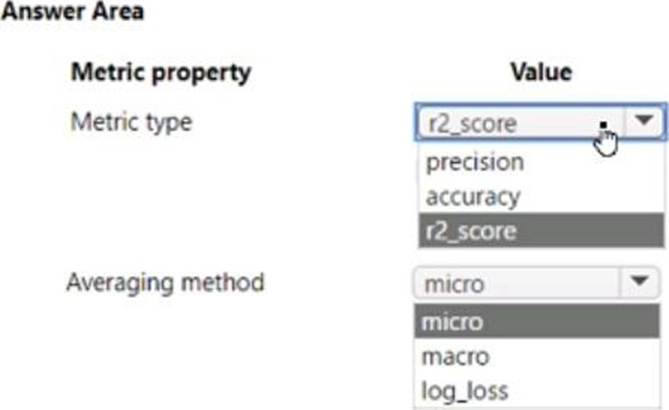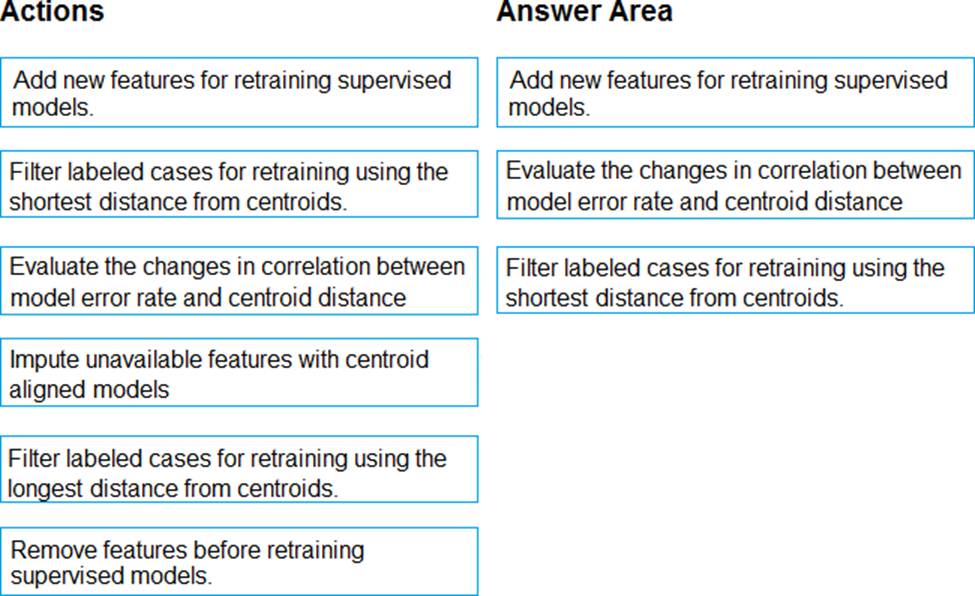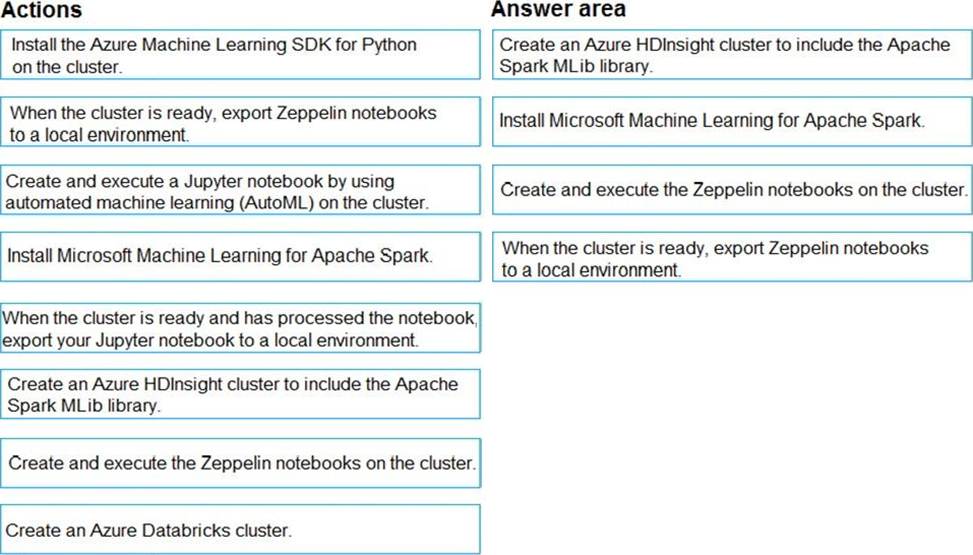Practice Free DP-100 Exam Online Questions
DRAG DROP
You need to define an evaluation strategy for the crowd sentiment models.
Which three actions should you perform in sequence? To answer, move the appropriate actions from the list of actions to the answer area and arrange them in the correct order.
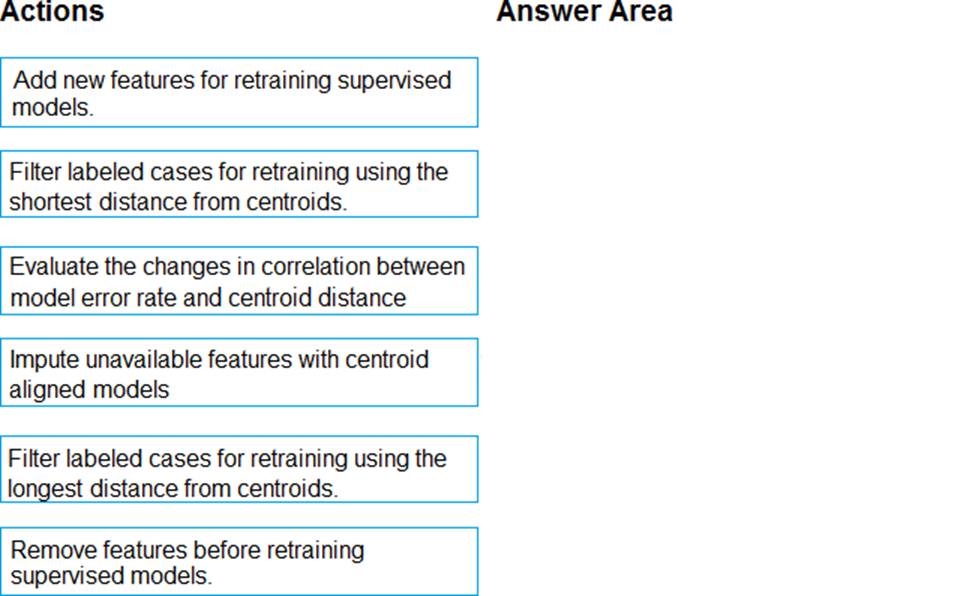
DRAG DROP
You are building an intelligent solution using machine learning models.
The environment must support the following requirements:
✑ Data scientists must build notebooks in a cloud environment
✑ Data scientists must use automatic feature engineering and model building in machine learning pipelines.
✑ Notebooks must be deployed to retrain using Spark instances with dynamic worker allocation.
✑ Notebooks must be exportable to be version controlled locally.
You need to create the environment.
Which four actions should you perform in sequence? To answer, move the appropriate actions from the list of actions to the answer area and arrange them in the correct order.
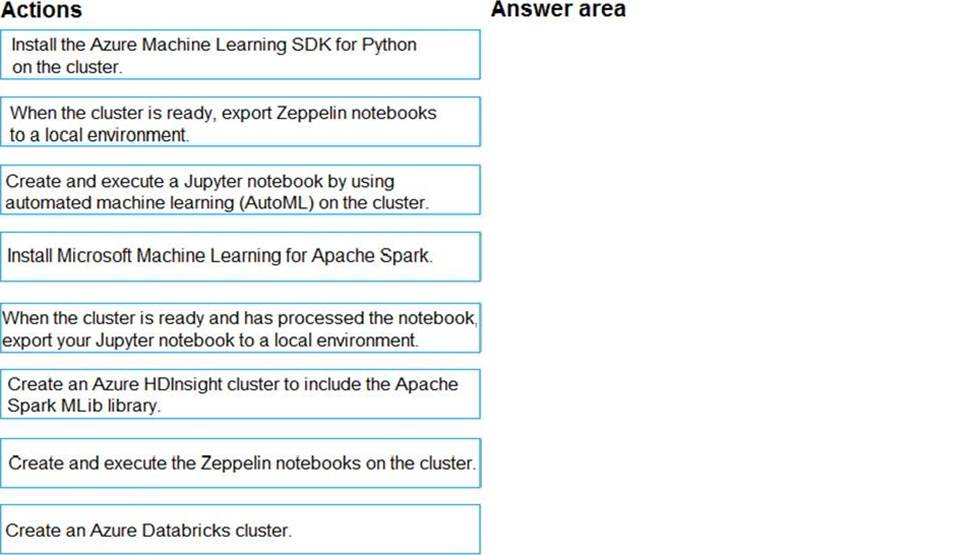
DRAG DROP
You are building an intelligent solution using machine learning models.
The environment must support the following requirements:
✑ Data scientists must build notebooks in a cloud environment
✑ Data scientists must use automatic feature engineering and model building in machine learning pipelines.
✑ Notebooks must be deployed to retrain using Spark instances with dynamic worker allocation.
✑ Notebooks must be exportable to be version controlled locally.
You need to create the environment.
Which four actions should you perform in sequence? To answer, move the appropriate actions from the list of actions to the answer area and arrange them in the correct order.

You use an Azure Machine Learning workspace.
You must monitor cost at the endpoint and deployment level.
You have a trained model that must be deployed as an online endpoint. Users must authenticate by using Microsoft Entra ID.
What should you do?
- A . Deploy the model lo Azure Kubernetes Service (AKS). During deployment, set the token_auth_mode parameter of the target configuration object to true.
- B . Deploy the model to a managed online endpoint. During deployment, set the token_auth_mode parameter of the target configuration object to true.
- C . Deploy the model to Azure Kubernetes Service (AKS). During deployment, set the auth.mode parameter to configure the authentication type.
- D . Deploy the model to a managed online endpoint. During deployment, set the auth_mode parameter to configure the authentication type.
You use an Azure Machine Learning workspace.
You must monitor cost at the endpoint and deployment level.
You have a trained model that must be deployed as an online endpoint. Users must authenticate by using Microsoft Entra ID.
What should you do?
- A . Deploy the model lo Azure Kubernetes Service (AKS). During deployment, set the token_auth_mode parameter of the target configuration object to true.
- B . Deploy the model to a managed online endpoint. During deployment, set the token_auth_mode parameter of the target configuration object to true.
- C . Deploy the model to Azure Kubernetes Service (AKS). During deployment, set the auth.mode parameter to configure the authentication type.
- D . Deploy the model to a managed online endpoint. During deployment, set the auth_mode parameter to configure the authentication type.
You use an Azure Machine Learning workspace.
You must monitor cost at the endpoint and deployment level.
You have a trained model that must be deployed as an online endpoint. Users must authenticate by using Microsoft Entra ID.
What should you do?
- A . Deploy the model lo Azure Kubernetes Service (AKS). During deployment, set the token_auth_mode parameter of the target configuration object to true.
- B . Deploy the model to a managed online endpoint. During deployment, set the token_auth_mode parameter of the target configuration object to true.
- C . Deploy the model to Azure Kubernetes Service (AKS). During deployment, set the auth.mode parameter to configure the authentication type.
- D . Deploy the model to a managed online endpoint. During deployment, set the auth_mode parameter to configure the authentication type.
DRAG DROP
You manage an Azure Machine Learning workspace named workspaces
You plan to create a registry named registry01 with the help of the following registry.yml (line numbers are used for reference only):

You need to use Azure Machine Learning Python SDK v2 with Python 3.10 in a notebook to interact with workspace1.
Which three actions should you perform in sequence? To answer, move the appropriate actions from the list of actions to the answer area and arrange them in the correct order.

Note: This question is part of a series of questions that present the same scenario. Each question in the series contains a unique solution that might meet the stated goals. Some question sets might have more than one correct solution, while others might not have a correct solution.
After you answer a question in this section, you will NOT be able to return to it. As a result, these questions will not appear in the review screen.
You are creating a model to predict the price of a student’s artwork depending on the following variables: the student’s length of education, degree type, and art form.
You start by creating a linear regression model.
You need to evaluate the linear regression model.
Solution: Use the following metrics: Relative Squared Error, Coefficient of Determination, Accuracy, Precision, Recall, F1 score, and AUC.
Does the solution meet the goal?
- A . Yes
- B . No
You create a deep learning model for image recognition on Azure Machine Learning service using GPU-based training.
You must deploy the model to a context that allows for real-time GPU-based inferencing.
You need to configure compute resources for model inferencing.
Which compute type should you use?
- A . Azure Container Instance
- B . Azure Kubernetes Service
- C . Field Programmable Gate Array
- D . Machine Learning Compute
HOTSPOT
You create an Azure Machine Learning workspace. You train a classification model by using automated machine learning (automated ML) in Azure Machine Learning studio. The training data contains multiple classes that have significantly different numbers of samples.
You must use a metric type to avoid labeling negative samples as positive and an averaging method that will minimize the class imbalance.
You need to configure the metric type and the averaging method.
Which configurations should you use? To answer, select the appropriate options in the answer area. NOTE: Each correct selection is worth one point.
